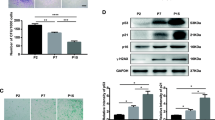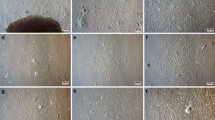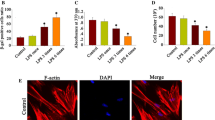Abstract
Primary stem cells, after several cell divisions, enter into a senescence state, that is characterized by alterations to spindle-shape typical morphology. This concern is one of the main problems in the use of human mesenchymal stem cells (hMSCs) in clinical applications which demand cells in large numbers. Short peptides had geroprotective properties and stimulated stem cell differentiation. The aim of the study is to demonstrate the role of AEDG and KED peptides in maintaining oral hMSCs morphology and functions over long-term expansion. 2 types of hMSCs were investigated: human periodontal ligament stem cells (hPLSCs) and human gingival mesenchymal stem cells (hGMSCs). Cells at the 25th passage were divided into 3 groups: 1 – control (without adding peptide), 2 – treated with AEDG peptide, 3 – treated with KED peptide. Cell cultures were analyzed by an immunofluorescence method and RT-PCR on the p16 and p21 senescence markers expression. AEDG peptide decreased p16 and p21 mRNA expression by 1.56–2.44 times in comparison with the control group. KED peptide decreased p16 and p21 mRNA expression by 1.82–3.23 times in comparison with the control group. These results were confirmed by immunofluorescent visualization. AEDG and KED peptides could be used as supplementary substances in a culture medium to delay the expression of senescence markers in long term stem cell cultivation in order to promote the large-scale in vitro expansion necessarily required for stem cell therapy clinical application. The data obtained confirm the geroprotective effect of AEDG and KED peptide, which was shown early in animal and cells models.




Similar content being viewed by others
References
Bonab, M. M., Alimoghaddam, K., Talebian, F., Ghaffari, S. H., Ghavamzadeh, A., & Nikbin, B. (2006). Aging of mesenchymal stem cell in vitro. BMC Cell Biology, 10(7), 14.
Wagner, W., Ho, A. D., & Zenke, M. (2010). Different facets of aging in human mesenchymal stem cells. Tissue Engineering Part B, Reviews, 16(4), 445–453.
De Becker, A., & Van Riet, I. (2016). Homing and migration of mesenchymal stromal cells: How to improve the efficacy of cell therapy? World Journal of Stem Cells, 8(3), 73–87.
Honczarenko, M., Le, Y., Swierkowski, M., Ghiran, I., Glodek, A. M., & Silberstein, L. E. (2006). Human bone marrow stromal cells express a distinct set of biologically functional chemokine receptors. Stem Cells, 24(4), 1030–1041.
Kassem, M. (2006). Stem Cells potential therapy for age-related diseases. Annals of the New York Academy of Sciences, 1067, 436–442.
Yu, J. H., He, H. X., Tang, C. B., et al. (2010). Differentiation potential of STRO-1(+) dental pulp stem cells changes during cell passaging. BMC Cell Biology, 8, 11.
Dhanasekaran, M., Indumathi, S., Lissa, R. P., Harikrishnan, R., Rajkumar, J. S., & Sudarsanam, D. (2013). A comprehensive study on optimization of proliferation and differentiation potency of bone marrow derived mesenchymal stem cells under prolonged culture condition. Cytotechnology, 65(2), 187–197.
Park, Y. J., Cha, S. H., & Park, Y. S. (2016). Regenerative applications using tooth derived stem cells in other than tooth regeneration: a literature review. Stem Cells International. https://doi.org/10.1155/2016/9305986.
Zare, H., Jamshidi, S., Dehghan, M. M., Saheli, M., & Piryaei, A. (2018). Bone marrow or adipose tissue mesenchymal stem cells: comparison of the therapeutic potentials in mice model of acute liver failure. Journal of Cellular Biochemistry, 119(7), 5834–5842.
Kerkis, I., Kerkis, A., Dozortsev, D., et al. (2006). Isolation and characterization of a population of immature dental pulp stem cells expressing OCT-4 and other embryonic stem cell markers. Cells, Tissues, Organs, 184(3–4), 105–116.
Gould, T. R., Melcher, A. H., & Brunette, D. M. (1977). Location of progenitor cells in periodontal ligament of mouse molar stimulated by wounding. The Anatomical Record, 188(2), 133–141.
McCulloch, C. A., Nemeth, E., Lowenberg, B., & Melcher, A. H. (1987). Paravascular cells in endosteal spaces of alveolar bone contribute to periodontal ligament cell populations. The Anatomical Record, 219(3), 233–242.
Seo, B. M., Miura, M., Gronthos, S., et al. (2004). Investigation of multipotent postnatal stem cells from human periodontal ligament. Lancet, 364(9429), 149–155.
Diomede, F., Zini, N., Pizzicannella, J., et al. (2018). 5-Aza exposure improves reprogramming process through embryoid body formation in human gingival stem cells. Frontiers in Genetics. https://doi.org/10.3389/fgene.2018.00419.
Ballerini, P., Diomede, F., Petragnani, N., et al. (2017). Conditioned medium from relapsing-remitting multiple sclerosis patients reduces the expression and release of inflammatory cytokines induced by LPS-gingivalis in THP-1 and MO3.13 cell lines. Cytokine, 96, 261–272.
Cavalcanti, M. F., Maria, D. A., de Isla, N., et al. (2015). Evaluation of the proliferative effects induced by low-level laser therapy in bone marrow stem cell culture. Photomedicine and Laser Surgery, 33(12), 610–616.
Rajan, T. S., Giacoppo, S., Trubiani, O., et al. (2016). Conditioned medium of periodontal ligament mesenchymal stem cells exert anti-inflammatory effects in lipopolysaccharide-activated mouse motoneurons. Experimental Cell Research, 349(1), 152–161.
Giacoppo, S., Thangavelu, S. R., Diomede, F., et al. (2017). Anti-inflammatory effects of hypoxia-preconditioned human periodontal ligament cell secretome in an experimental model of multiple sclerosis: a key role of IL-37. FASEB Journal : Official Publication of the Federation of American Societies for Experimental Biology, 31(12), 5592–5608.
Gugliandolo, A., Diomede, F., Cardelli, P., et al. (2018). Transcriptomic analysis of gingival mesenchymal stem cells cultured on 3D bioprinted scaffold: a promising strategy for neuroregeneration. Journal of Biomedical Materials Research Part A, 106(1), 126–137.
Rajan, T. S., Scionti, D., Diomede, F., et al. (2017). Gingival stromal cells as an in vitro model: cannabidiol modulates genes linked with amyotrophic lateral sclerosis. Journal of Cellular Biochemistry, 118(4), 819–828.
Diomede, F., Gugliandolo, A., Scionti, D., et al. (2018). Biotherapeutic effect of gingival stem cells conditioned medium in bone tissue restoration. International Journal of Molecular Sciences. https://doi.org/10.3390/ijms19020329.
Diomede, F., Gugliandolo, A., Cardelli, P., et al. (2018). Three-dimensional printed PLA scaffold and human gingival stem cell-derived extracellular vesicles: a new tool for bone defect repair. Stem Cell Research & Therapy, 9(1), 104.
Trubiani, O., Pizzicannella, J., Caputi, S., et al. (2019). Periodontal ligament stem cells: current knowledge and future perspectives. Stem Cells. https://doi.org/10.1089/scd.2019.0025.
Khavinson, V. K., Linkova, N. S., & Tarnovskaya, S. I. (2016). Short peptides regulate gene expression. Bulletin of Experimental Biology and Medicine, 162(2), 288–292.
Khavinson, V. K., Bondarev, I. E., & Butyugov, A. A. (2003). Epithalon peptide induces telomerase activity and telomere elongation in human somatic cells. Bulletin of Experimental Biology and Medicine, 135(6), 590–592.
Khavinson, V. K., Bondarev, I. E., Butyugov, A. A., & Smirnova, T. D. (2004). Peptide promotes overcoming of the division limit in human somatic cell. Bulletin of Experimental Biology and Medicine, 137(5), 613–616.
Anisimov, V. N., & Khavinson, V. (2010). Peptide bioregulation of aging: results and prospects. Biogerontology, 11(2), 139–149.
Khavinson, V. K., Tarnovskaia, S. I., Lin'kova, N. S., Guton, E. O., & Elashkina, E. V. (2014). Epigenetic aspects of peptidergic regulation of vascular endothelial cell proliferation during aging. Advances in Gerontology, 27(1), 108–114.
Khavinson, V. K., Linkova, N. S., Elashkina, E. V., Durnova, A. O., & Kozlov, K. L. (2014). Molecular aspects of anti-atherosclerotic effects of short peptides. Bulletin of Experimental Biology and Medicine, 158(1), 159–163.
Kitachev, K. V., Sazonov, A. B., Kozlov, K. L., Petrov, K. I., Sliusarev, A. S., & Khavinson, V. K. (2014). The efficacy of peptide bioregulators of vessels in lower limbs chronic arterial insufficiency treatment in old and elderly people. Advances in Gerontology, 27(1), 156–190.
Caputi, S., Trubiani, O., Sinjari, B., et al. (2019). Effect of short peptides on neuronal differentiation of stem cells. International Journal of Immunopathology and Pharmacology. https://doi.org/10.1177/2058738419828613.
Pizzicannella, J., Diomede, F., Merciaro, I., et al. (2018). Endothelial committed oral stem cells as modelling in the relationship between periodontal and cardiovascular disease. Journal of Cellular Physiology, 233(10), 6734–6747.
Libro, R., Scionti, D., Diomede, F., et al. (2016). Cannabidiol modulates the immunophenotype and inhibits the activation of the inflammasome in human gingival mesenchymal stem cells. Frontiers in Physiology, 7, 559.
Pizzicannella, J., Gugliandolo, A., Orsini, T., et al. (2019). Engineered extracellular vesicles from human periodontal-ligament stem cells increase VEGF/VEGFR2 expression during bone regeneration. Frontiers in Physiology, 10, 512.
Diomede, F., Rajan, T. S., Gatta, V., et al. (2017). Stemness maintenance properties in human oral stem cells after long-term passage. Stem Cells International. https://doi.org/10.1155/2017/5651287.
Diomede, F., Merciaro, I., Martinotti, S., et al. (2016). miR-2861 is involved in osteogenic commitment of human periodontal ligament stem cells grown onto 3D scaffold. Journal of Biological Regulators and Homeostatic Agents, 30(4), 1009–1018.
Pizzicannella, J., Cavalcanti, M., Trubiani, O., & Diomede, F. (2018). MicroRNA 210 mediates VEGF upregulation in human periodontal ligament stem cells cultured on 3D hydroxyapatite ceramic scaffold. International Journal of Molecular Sciences. https://doi.org/10.3390/ijms19123916.
Diomede, F., Zini, N., Gatta, V., et al. (2016). Human periodontal ligament stem cells cultured onto cortico-cancellous scaffold drive bone regenerative process. European Cells & Materials, 32, 181–201.
Ivanov, V. T., Karelin, A. A., Philippova, M. M., Nazimov, I. V., & Pletnev, V. Z. (1997). Hemoglobin as a source of endogenous bioactive peptides: the concept of tissue-specific peptide pool. Biopolymers, 43(2), 171–188.
Khavinson, V. K. (2002). Peptides and ageing. Neuroendocrinology Letters, 23(3), 11–144.
Labrador-Velandia, S., Alonso-Alonso, M. L., Di Lauro, S., et al. (2019). Mesenchymal stem cells provide paracrine neuroprotective resources that delay degeneration of co-cultured organotypic neuroretinal cultures. Experimental Eye Research. https://doi.org/10.1016/j.exer.2019.05.011.
Trubiani, O., Toniato, E., Di Iorio, D., et al. (2012). Morphological analysis and interleukin release in human gingival fibroblasts seeded on different denture base acrylic resins. International Journal of Immunopathology and Pharmacology, 25(3), 637–643.
Manescu, A., Giuliani, A., Mohammadi, S., et al. (2016). Osteogenic potential of dualblocks cultured with human periodontal ligament stem cells: in vitro and synchrotron microtomography study. Journal of Periodontal Research, 51(1), 112–124.
Trubiani, O., Ballerini, P., Murmura, G., et al. (2012). Toll-like receptor 4 expression, interleukin-6,-8 and Ccl-20 release, and Nf-Kb translocation in human periodontal ligament mesenchymal Stem cells stimulated with Lps-P-Gingivalis. European Journal ofa Inflammation, 10(1), 81–89.
Turinetto, V., Vitale, E., & Giachino, C. (2016). Senescence in human mesenchymal stem cells: functional changes and implications in stem cell based therapy. International Journal of Molecular Sciences. https://doi.org/10.3390/ijms17071164.
Mammana, S., Gugliandolo, A., Cavalli, E., et al. (2019). Human gingival mesenchymal stem cells (GMSCs) pre-treated with vesicular Moringin nanostructures as a new therapeutic approach in a mouse model of spinal cord injury. Journal of Tissue Engineering and Regenerative Medicine. https://doi.org/10.1002/term.2857.
Khavinson, V. K., Kopylov, A. T., Vaskovsky, B. V., Ryzhak, G. A., & Linkova, N. S. (2017). Identification of peptide AEDG in the polypeptide complex of the pineal gland. Bulletin of Experimental Biology and Medicine, 164(1), 41–43.
Lin'kova, N. S., Drobintseva, A. O., Orlova, O. A., et al. (2016). Peptide regulation of skin fibroblast functions during their aging in vitro. Bulletin of Experimental Biology and Medicine, 161(1), 175–178.
Khavinson, V. K., Lezhava, T. A., Monaselidze, J. R., et al. (2003). Peptide Epitalon activates chromatin at the old age. Neuroendocrinology Letters, 24(5), 329–333.
Rosenfeld, S. V., Togo, E. F., Mikheev, V. S., et al. (2002). Effect of epithalon on the incidence of chromosome aberrations in senescence-accelerated mice. Bulletin of Experimental Biology and Medicine, 133(3), 274–276.
Kozina, L. S., Arutjunyan, A. V., & Khavinson, V. K. (2007). Antioxidant properties of geroprotective peptides of the pineal gland. Archives of Gerontology and Geriatrics, 44, 213–216.
Stone, S., Jiang, P., Dayananth, P., et al. (1995). Complex structure and regulation of the P16 (Mts1) Locus. Cancer Research, 55(14), 2988–2994.
Rayess, H., Wang, M. B., & Srivatsan, E. S. (2012). Cellular senescence and tumor suppressor gene p16. International Journal of Cancer, 130(8), 1715–1725.
Kim, W. Y., & Sharpless, N. E. (2006). The regulation of INK4/ARF in cancer and aging. Cell., 127(2), 265–275.
Chkhotua, A. B., Gabusi, E., Altimari, A., et al. (2003). Increased expression of p16(INK4a) and p27(Kip1) cyclin-dependent kinase inhibitor genes in aging human kidney and chronic allograft nephropathy. American Journal of Kidney Diseases, 41(6), 1303–1313.
Eldeiry, W. S., Tokino, T., Velculescu, V. E., et al. (1993). Waf1, a potential mediator of P53 tumor suppression. Cell, 75(4), 817–825.
McConnell, B. B., Starborg, M., Brookes, S., & Peters, G. (1998). Inhibitors of cyclin-dependent kinases induce features of replicative senescence in early passage human diploid fibroblasts. Current Biology, 8(6), 351–354.
Cheng, T., Rodrigues, N., Shen, H., et al. (2000). Hematopoietic stem cell quiescence maintained by p21cip1/waf1. Science., 287(5459), 1804–1808.
Author information
Authors and Affiliations
Corresponding author
Ethics declarations
Conflict of interests
The authors declare no conflict of interests.
Additional information
Publisher’s Note
Springer Nature remains neutral with regard to jurisdictional claims in published maps and institutional affiliations.
Rights and permissions
About this article
Cite this article
Sinjari, B., Diomede, F., Khavinson, V. et al. Short Peptides Protect Oral Stem Cells from Ageing. Stem Cell Rev and Rep 16, 159–166 (2020). https://doi.org/10.1007/s12015-019-09921-3
Published:
Issue Date:
DOI: https://doi.org/10.1007/s12015-019-09921-3




